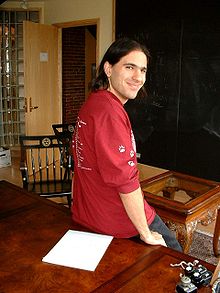Nima Arkani-Hamed
Nima Arkani-Hamed (* 5. April 1972 in Houston , Texas ) is an American-Canadian theoretical physicist with research interests particle physics , string theory and cosmology . He is considered one of the leading theoretical high-energy physicists of his generation.
Life
In addition to the US , Arkani-Hamed is also a Canadian citizen. His parents, both also physicists, come from Iran . His father, Jafar Arkani-Hamed (* 1940), worked for the Apollo program in Houston in the early 1970s and was director of the Institute of Physics at Sharif University of Technology in Tehran . After the Islamic Revolution of 1979, Jafar Arkani-Hamed, who had initially welcomed the revolution, publicly protested against the Iranian Revolutionary Guards , which is why the family had to flee across the Turkish border on horses in 1981 . After crossing the border, they tore their Iranian passports and emigrated to Canada, where Nima Arkani-Hamed finished his schooling and studied physics at the University of Toronto . His father is a Canadian citizen and has been Professor of Geology at the University of Toronto since 1982 and Professor of Planetary Science at McGill University since 1988 . The mother Hamideh Alasti von Arkani-Hamed and his sister Sanaz "Sunny" Jensen are also physicists.
Nima Arkani-Hamed plays the piano and appeared in the 2013 documentary Particle Fever by Mark Levinson and David E. Kaplan about the discovery of the Higgs boson at the LHC .
Academic career
Arkani-Hamed received his doctorate in 1997 from the University of California, Berkeley with Lawrence John Hall with a thesis on Supersymmetry and Hierarchies and then worked from 1997 to 1999 as a post-doctoral student at SLAC ( Stanford University ). In 1999 he became an assistant professor and an associate professor in 2001 at Berkeley, and in 2001 was also a visiting professor at Harvard University . From 2002 to 2008 he was a full professor at Harvard and in 2008 moved to the Institute for Advanced Study at Princeton . He is also a frequent guest at the Perimeter Institute in Waterloo, Ontario .
research
Arkani-Hamed made important contributions in the field of large extra dimensions (additional space-time dimensions that are larger than the Planck length ), to deconstruction theory (with Howard Georgi and Andrew Cohen) and to ghost condensation.
After a number of symmetries in the perturbation series development, for example in quantum chromodynamics and supersymmetric Yang-Mills theories, were discovered in the 1990s and 2000s (among other things through the use of Twistor formalism and BCFW recursion relations), which reduced the number of Feynman diagrams to be considered greatly reduced, Arkani-Hamed was with colleagues as his doctoral Jaroslav Trnka , Jacob Bourjaly and Freddy Cachazo late 2000s a geometrical explanation in the form of already in the algebraic geometry known positive Grassmann manifold . In this theory, the calculation of scattering amplitudes amounts to determining the volume of objects, which Arkani-Hamed and colleagues call amplituhedron - this can be done with ordinary Feynman diagrams, Twistor methods or geometrically. Arkani-Hamed hopes to find an approach to quantum gravity that is independent of space-time variables.
Awards and honors
In 2003 he received the Gribov Medal and in 2008 the Rymond and Beverly Sackler Prize in Physics from Tel Aviv University . In 2012 he was awarded the Fundamental Physics Prize . He was a Sloan Fellow from 2000 to 2002 and a Packard Fellow from 2000 to 2005 and is a member of the American Academy of Arts and Sciences (2009) and the National Academy of Sciences (2017). In 2010 Arkani-Hamed gave the Messenger Lectures in Cornell .
literature
- Geoff Brumfiel: In search of hidden dimensions . In: Nature . Volume 433, January 6, 2005, p. 10, doi: 10.1038 / 433010a
Web links
- Nima Arkani-Hameds Homepage (English)
- Publications on INSPIRE-HEP (English)
- Preprints . In: arXiv.org (English)
- Branes. To interview Dr. Nima Arkani-Hamed (English)
Individual evidence
- ↑ a b short biography
- ^ Visions of Future Physics . In: Wired , October 4, 2015. Retrieved July 11, 2018.
- ↑ Biography of Jafar Arkani-Hamed in American Men and Women of Science , Thomson Gale 2004
- ↑ Particle Fever in the Internet Movie Database
- ^ Mathematics Genealogy Project
- ^ Nima Arkani-Hamed, Savas Dimopoulos and Gia Dwali : The Hierarchy problem and new dimensions at a millimeter . In: Physics Letters B . Volume 429, 1998, pp. 263-272, hep-ph / 9803315 ; Ignatios Antoniadis , Nima Arkani-Hamed, Savas Dimopoulos and Gia Dvali: New dimensions at a millimeter to a Fermi and superstrings at a TeV . In: Physics Letters B . Volume 436, 1998, pp. 257-263, hep-ph / 9804398 ; Nima Arkani-Hamed, Savas Dimopoulos and Gia Dvali: Phenomenology, astrophysics and cosmology of theories with submillimeter dimensions and TeV scale quantum gravity . In: Physical Review D . Volume 59, 1999, p. 086004, hep-ph / 9807344
- ↑ Starting with Stephen Parke, Tommy Taylor 1986, who were able to greatly reduce the number of diagrams in the QCD at the transition amplitude from 2 to 4 gluons.
- ↑ Nima Arkani-Hamed, Jacob L. Bourjaily, Freddy Cachazo, Alexander B. Goncharov , Alexander Postnikov, Jaroslav Trnka Scattering amplitudes and the positive Grassmannian , Abstract , 2012
- ^ Nima Arkani-Hamed, Jacob Bourjaily, Freddy Cachazo, Jaroslav Trnka Local Spacetime Physics from the Grassmannian , Preprint 2009 , Journal High Energy Physics
- ↑ Natalie Wolcher A jewel at the heart of quantum physics , Simons Foundation 2013
| personal data | |
|---|---|
| SURNAME | Arkani-Hamed, Nima |
| BRIEF DESCRIPTION | American-Canadian theoretical physicist |
| DATE OF BIRTH | April 5th 1972 |
| PLACE OF BIRTH | Houston , Texas |
